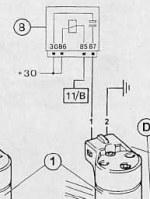Background:
barchetta -95 w 100kkm on the odometer, it's fairly new to me (my daughters).
Concerning the drive train I've only done some minor stuff; straightened out a kink on the fuel vapour hose (between the charcoal canister and the manifold), changed the thermostat, (and installed a new heat shield). Before changing the thermostat the warm idle was hunting and the engine would be close to stalling, so I was checking spark plugs, coils, icv, and all looked decent. Since then I have found a couple of places where a previous owner and/or mechanic has missed torquing down bolts/nuts (power steering fluid container and lid over fuel pump ass.) and a number of missing bolts and nuts (eg power steering fluid container, driver door handle, fuse compartment). The cam belt and water pump was recently changed by a small shop for a previous owner (according to the service booklet).
Yesterday, it started with a clonk:
My daughter started driving after a stop and there was a large clonk at around 50kph, they could not see anything having fallen off and the car performed ok (and there were no warning lights). After driving through a roundabout they were speeding up to enter the freeway, but when revving up over 2krpm there was a new rattling noise. When letting the rpm drop the rattle quit.
Today:
I tested the b today; it started beautifully, but I also got the rattle at 2krpm when driving. At first I only thought it was a vibration sound so I tore out the newly installed heat shield (did nothing). When only revving the engine (without gear and without driving) the rattle tends to start at higher rpm and sometimes there is no rattle. In one instance I heard the engine being affected by the rattle (not every time), it would not fire as "cleanly". The rattle will quit with rpm dropping and may quit when revving more. Without pressing the gas pedal any further the rpm will fairly slowly continue to rise from 3,2krpm to 4krpm. The rattle will appears "every" time when driving in gear and at just above 2krpm.
A previous owner/mechanic has installed some Alfa Romeo/Lancia parts on the b, including the oil stick(!), I hope it is showing the correct interval (at least no warning light).... Wondering if the variator might not have enough of a oil pressure and the dip stick showing half way, I topped off the oil. This did nothing.
Clueless and pleading for ideas:
Do you have any experience with this type of issue on a b? Any ideas where to start looking? At the moment I believe it is a mechanical problem and not a rusted through heat shield type of deal.
Thanks,
T
barchetta -95 w 100kkm on the odometer, it's fairly new to me (my daughters).
Concerning the drive train I've only done some minor stuff; straightened out a kink on the fuel vapour hose (between the charcoal canister and the manifold), changed the thermostat, (and installed a new heat shield). Before changing the thermostat the warm idle was hunting and the engine would be close to stalling, so I was checking spark plugs, coils, icv, and all looked decent. Since then I have found a couple of places where a previous owner and/or mechanic has missed torquing down bolts/nuts (power steering fluid container and lid over fuel pump ass.) and a number of missing bolts and nuts (eg power steering fluid container, driver door handle, fuse compartment). The cam belt and water pump was recently changed by a small shop for a previous owner (according to the service booklet).
Yesterday, it started with a clonk:
My daughter started driving after a stop and there was a large clonk at around 50kph, they could not see anything having fallen off and the car performed ok (and there were no warning lights). After driving through a roundabout they were speeding up to enter the freeway, but when revving up over 2krpm there was a new rattling noise. When letting the rpm drop the rattle quit.
Today:
I tested the b today; it started beautifully, but I also got the rattle at 2krpm when driving. At first I only thought it was a vibration sound so I tore out the newly installed heat shield (did nothing). When only revving the engine (without gear and without driving) the rattle tends to start at higher rpm and sometimes there is no rattle. In one instance I heard the engine being affected by the rattle (not every time), it would not fire as "cleanly". The rattle will quit with rpm dropping and may quit when revving more. Without pressing the gas pedal any further the rpm will fairly slowly continue to rise from 3,2krpm to 4krpm. The rattle will appears "every" time when driving in gear and at just above 2krpm.
A previous owner/mechanic has installed some Alfa Romeo/Lancia parts on the b, including the oil stick(!), I hope it is showing the correct interval (at least no warning light).... Wondering if the variator might not have enough of a oil pressure and the dip stick showing half way, I topped off the oil. This did nothing.
Clueless and pleading for ideas:
Do you have any experience with this type of issue on a b? Any ideas where to start looking? At the moment I believe it is a mechanical problem and not a rusted through heat shield type of deal.
Thanks,
T



